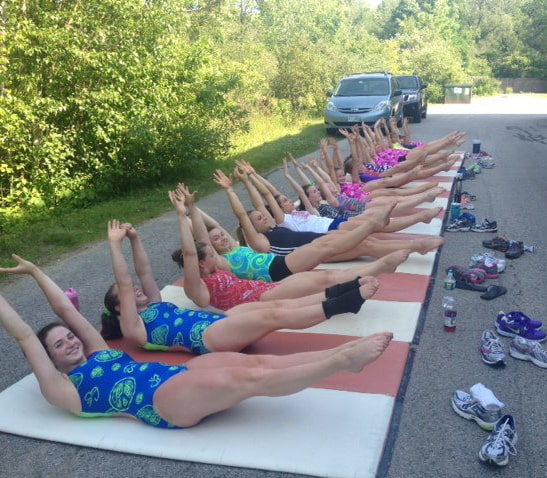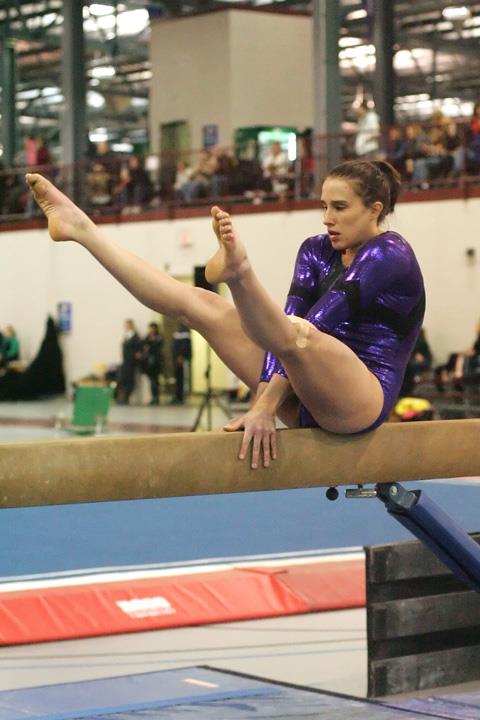- Home
- Our Programs
- Gymnasts and Pelvic Floor
|
||
| site search by freefind |
Gymnasts and Pelvic Floor: This Area of the Body is a Critically Important Part of the Entire Core System
If a gymnast's pelvic floor isn't as strong as the rest of her core, she's leaving valuable strength on the table that she desperately needs for her sport
 Gina Paulhus has been a lifelong gymnast, competing both as a child and as an adult. She also happens to be a pelvic floor expert!
Gina Paulhus has been a lifelong gymnast, competing both as a child and as an adult. She also happens to be a pelvic floor expert!I competed in high level gymnastics through my late 30s. I noticed that the stronger I was able to make my core and my pelvic floor, the better my gymnastics got, and the healthier my body was while performing my favorite sport! It really was a game changer for me, and allowed me to stay in the sport longer than I otherwise would have. You're so smart to be looking into this, because the pelvic floor truly is an integral part of any gymnast's health.
Our pelvic floor works with our abdominals to stabilize our body. Abdominal muscle activity is a normal response during pelvic floor contraction in those who have no symptoms of pelvic floor muscle dysfunction.1 In those with healthy pelvic floors, the pelvic floor contraction automatically kicks in before abdominal pressure increases (hello, gymnastics skills!).
When the system is healthy, the pelvic floor works to assist in abdominal contraction, increasing core strength and stabilizing the spine and pelvis during skills. We want to work to connect to the pelvic floor muscles and the transverse abdominus (our "corset" muscles that wrap around our core and hold our abs in). We can do this via specialized core exercises such as dead bugs or twisting crunches performed with zero pelvic movement and with our abs flattening versus bulging while we do it.
We can then build up to bringing that good form on hollow holds and planks to tie it back to gymnastics. If you are concerned about the functioning of your abdominals in particular, check out gymnasts and diastasis article.

A lot of people think a few sets of Kegels each day will take care of a pelvic floor problem. Not so fast! Kegels are great for some women and girls and will absolutely cause more problems than they solve for others....More on that below!
Ready? Let's go! If you or your gymnast would like to work with Gina Paulhus strengthening the pelvic floor, book a Free Discovery Call or an Online session.
Pelvic Floor Issues are Common in Gymnasts of All Ages
The first thing to know is that pelvic floor issues are exceedingly common in athletes. 52.5% athletes deal with incontinence to some degree. A literature review demonstrated that the prevalence of urinary incontinence can range from 28% to 80% in sports such as trampolining, gymnastics, aerobic gymnastics, hockey and dance.2
This pelvic floor dysfunction comes at a steep price. 28% of US women who report urinary incontinence find it to be at least a moderate barrier to exercise. Of the women with urinary incontinence, 11.6% did not exercise because of it, 11.3% exercised less, 12.4% changed the type of exercise and 5% stopped exercising in a group setting altogether. For women with severe urinary incontinence, 1/3 did not exercise or exercised less because of urinary incontinence. This represents a lot of women and athletes who are changing their physical activity due to this issue!

Ideally, the transverse abdominus and our pelvic floor engage in co-contraction (meaning that they contract together, at the same time). For gymnasts who suffer from stress urinary incontinence, meaning that physical demands such as tumbling or vaulting increase their incontinence, working on this co-contraction via targeted exercises will improve their symptoms.3
It doesn’t have to be limited to a sports thing, though – even coughing and sneezing are a form of stress that can lead to urinary incontinence in some women. And yes, after having a baby, the odds of developing urinary incontinence go up – however, women and teens who have never been pregnant can be affected. Keep in mind, the statistics listed above are on all athletes, not exclusively on moms!
A healthy pelvic floor in an integral part of a healthy, balanced core system. It can also help minimize unpleasant symptoms such as leaking.
Pelvic floors that are too tight OR too weak can both cause problems. In gymnasts more often than not our pelvic floor is overly tight - which ironically can cause many of the same symptoms as having a weak pelvic floor! The pelvic floor can get overly tight when it has to work harder than nature intended. This happens when our core isn’t balanced or isn't strong enough to handle the pressure that we are asking it to.
Having a six-pack doesn’t necessarily mean you have a strong, balanced core. There are many abdominal muscles - and they all need to be as strong as the others to prevent bearing pressure down into our pelvic floor when we are doing strenuous activities such as gymnastics. Sometimes the symptoms of such dysfunction are leaking or vaginal flatulence. Other times the pressure becomes simply too great and we can suffer from organ prolapse, meaning that our organs end up sitting lower than they normally would. This can also cause leaking as well as a feeling of heaviness and pressure.
While Surgery is Available, Corrective Exercises are a Great First Step
Unfortunately, prolapse surgery is not an easy fix. For at least 50% of women, surgery alone won’t solve their problem and they will still need to engage in corrective exercise to teach the muscles how to show up the way they need to in order to handle the movements we are asking them to do.
The good news is that the very same exercises that are used to heal in rehab post-surgery can be used to help avoid the need for surgery for many women. So the cool thing is - the exercises can be tried before surgery is considered, potentially saving lots of time, money and heartache! The surgery will be there on the back burner if needed, but trying corrective exercises first makes a lot of sense!
Part of the goal of corrective exercise is to re-learn how to handle pressure in our system. There are gender differences to take note of! Research has shown that 50% of female athletes bear down as their core activation strategy versus 10% of men.
Ideally, we all will breathe in a 360 fashion - meaning that our lungs expand in all directions and we do not have to bear down towards our pelvic floor in order to increase stability in the system.
Let's try it together right now. Place your hands around your ribcage so that your thumbs are in back. Did you feel all of your ribs move underneath even your thumbs? If not, or if you felt the ones in the front move a lot more than the ones in the back, you could stand to improve your 360 breathing.

Another core problem comes when someone holds their stomach in on purpose. Many women and girls develop a habit of holding their stomach in (especially in judged sports where one is wearing a leotard such as with gymnastics) which then causes the pressure to go to the only place it can – downward to our pelvic floors.
The good thing is there are ways to decrease pressure that has nothing to do with watering down skills or sticking with easier conditioning.
We can...
- Work on relaxing our throat/glottis during movement
- Decrease breath holding in favor of doing a purposeful exhale before movement
- Work on our deep breathing (meaning 360 lung expansion) all day long.
Yes, sometimes we will want to peel back our skill work while we practice these things, but after you get good at the new ways of training, moving and breathing, you will find yourself stronger than ever and capable of reaching new heights with your training!
Another thing that is super helpful is thinking of how you can stack the parts of your torso one on top of the other to achieve the best alignment possible. Many gymnasts have or have developed a swayback where their lower back curves in noticeably and their belly protrudes forward a little.
In a system that's functioning like this, the abs cannot work to their best ability and instead the athlete will resort to bearing down for pressure management. In addition, the abs are in an overstretched state in this type of posture which weakens them. The odds of an athlete with this type of posture developing back pain are also far greater.
Are you curious to know if working with me can help you, your athlete or your daughter?
 The goal of corrective exercise is to be able to get back to traditional gymnastics conditioning and skills symptom-free.
The goal of corrective exercise is to be able to get back to traditional gymnastics conditioning and skills symptom-free.In gymnastics, we work the hollow position a lot out of necessity. But did you know that there are many ways to do a hollow that "looks" right, but is accomplished with the "wrong" muscles, meaning the muscles that do the work are not the most efficient ones for the job? In the best case, using these less-than-ideal muscles waste energy. In the worst case, you can develop back or hip pain and issues such as leaking, vaginal flatulence or prolapse. Most gymnastics coaches haven’t been trained to tell the difference. But if you spend time at a gymnastics club with girls and women, you will hear them joking about leaking or needing to run to the bathroom before tumbling. These are all signs that the pelvic floor and core muscles of these athletes aren’t functioning at their best. It even happens to elite gymnasts!
While the problems may be common, they are not normal and they should not ignored. These problems tend to get worse instead of better with age, and we don't want these women and girls struggling all their lives when something could be done today.
Let’s start talking about it with the right people who know how to help the problem versus just giggling about it and hoping for the best. The great thing too is that working on pelvic floor strength and balance will pay dividends whether or not a woman has had a baby or is hoping to or might have a baby one day. It’s an important part of our body that we can learn to help be the healthiest and strongest it can be.
Don't Forget About Getting Great (But Not Overly Tight) Glutes!
Did you know that overly tight glutes can also lead to peeing while tumbling or vaulting? This is because the pelvic floor cannot work optimally when the glutes are overly contracted. If you can develop the ability to lengthen glutes when engaging in dynamic movement your pelvic floor will be a lot more naturally responsive, just as nature intended! Then you won't have to think about a Kegel or anything like that while you are tumbling.
Doing Kegels when it’s not appropriate (it varies from person to person) can even make things worse. Being able to lengthen the glutes gives the pelvic floor a lot of support. Exercises to lengthen also feel really good because they stretch out the glutes. Exercises like airplanes, sitting into squats especially biasing toward thetight side, hip hikes and stretching into a deep squat can all really help.
Very few traditional gymnastics stretches actually help open up our deep hip rotators, which are part of our glutes and are muscles that work on overtime in a sport like gymnastics to help us stay on the beam and stick landings. Sometimes we need extra stretching into internal rotation to ease this tightness.
Strengthening the glutes in the right way can have amazing results too, since stronger glutes takes the pressure off the deep hip rotators. There is synergistic activation between the glutes and the pelvic floor.4 Sometimes a little bit of extra practice on these muscles working together can be useful, but then ultimately, we want to teach the gymnast to be able to isolate contracting just one or the other on command.

The way our pelvis is tilted can also be important. To get out of the common gymnastics posture of being in an anterior pelvic tilt (meaning that if our pelvis were a bowl, we would dump water out the front) we can work on inhibiting excessively active hip flexors. We also want to work on loosening paraspinals (muscles around the spine) as well as the QLs (quadratus lumborum) in the lower back and overly tight glutes. Gymnasts in particular tend to have super tight paraspinals due to all of the arching and straining that is done to complete skills.
To inhibit the hip flexors and paraspinals we can work on hip flexor releases as well as focusing on back and side breathing - otherwise known as 360 breathing as mentioned above. Again, splits and bridges don’t always fully stretch the hip flexors – instead they tend to crank more on the lower back. We can also relax the QLs with this same 360 breathing as well as by building up the glutes with exercises such as clamshells with our feet fixed on a wall as well as side planks.
When working side planks it's important to be able to breathe in a way that the side and back ribs are able to move and our body is slightly angled toward the floor to work more abs and hips and less back. We can also work on building the glutes and abs in a balanced way. Working the multifidi is another important component. The multifidi are a muscle that helps stabilize our spine, and it can only be worked during low level activities such as bird dogs on the hands and knees done with zero motion. It’s also the first muscle to fall asleep and have trouble coming back online when there is a back injury. Scapular muscles are another great thing for gymnasts to focus on.
Gymnastics conditioning tends to hit the large muscles such as the lats and rhomboids of the back really well, but not as much the smaller stabilizer muscles that are critical for core strength and shoulder, elbow and wrist health. My favorite exercises for muscles these muscle groups are various forms of Ys as well as serratus push-ups and a serratus foam roller up the wall exercise.
Our adductors (inner thigh muscles) also work synergistically with the pelvic floor.5 Strong adductors work like the anchors for the pelvis giving it support, strength and stability. We can work adductors by adding something to squeeze between our thighs such a pit foam block or a small ball or foam roller during corrective or typical gymnastics conditioning exercises.
Help is Available for Pelvic Floor Issues. I did gymnastics for 21 years - I get it! I've competed high level gymnastics as a child and as an adult.
 By building a strong pelvic floor that is in balance, your ability to last a long time in the sport and learn even more skills will soar!
By building a strong pelvic floor that is in balance, your ability to last a long time in the sport and learn even more skills will soar!Hopefully by now you can see that our core works as a wonderfully impressive, complex and amazing system. In gymnastics, we are asking our entire body to do superhuman things that require superhuman strength! Let’s be sure that these women and girls have a pelvic floor that is up to the high standard the rest of their muscles and body hold.
Using an expert to help ensure pelvic floor health and strength is an investment worth making. A little bit of education can go a long way. These exercises are easy and convenient to perform at home, which makes our in-home and zoom based lessons a perfect fit.
Because every body is different, individual consultations are necessary to ensure you have the best pelvic floor plan for yourself (or for your athlete or a loved one) to move forward. I offer one on one consultations with exercise plans and videos provided for your own continued education on your own time.
With just one visit I can set you up on the path for greater success and comfort in your sport. Follow-ups are available on as as-needed basis.
Ready? Let's Go! Set Up Your Consultation with Gina Paulhus, CPT and Corrective Exercise Specialist Today.
 It warms my heart to see an athlete overcome an obstacle such as pelvic floor difficulties!
It warms my heart to see an athlete overcome an obstacle such as pelvic floor difficulties!Online Appointments are available as well as in-person in select locations. You may request a Price Quote via the form below or you can book a Free 15 Minute Discovery Call to see if we are a good match. Taking care of this part of the body is essential to any gymnast's success in the sport (and functioning in life, too!).
What Will I Get During My Session?
The sessions are one hour and are conducted over Zoom or Facetime. If the client is a minor, an adult will need to be in attendance during the call. During the consultation we go over:
- Current symptoms or issues
- The recommendation of which exercises you'll need to move forward
- Expectations for results from the exercises as well as timeframe
- Instruction on how to perform the exercises assigned
After your appointment, you will be sent a written plan via email that includes links to videos that you can follow as you perform your exercises on your own. There also may be adjustments to how you do things in daily living or sport. We will ensure that your plan can fit into the time you have available to perform it. Follow-up visits may be scheduled as needed. You also will receive check-ins if desired from your trainer to see how the plan is going. You will have access to your trainer for support or questions.
You can always start with a Free 15 Minute Discovery call if you are not ready to book an appointment. Schedule your free call now - this will be conducted over your choice of audio call, Zoom or Facetime. During this call, you'll have a chance to ask questions and make sure the program is a good fit for your needs and concerns. You can also go ahead and schedule a 60 minute appointment with Gina Paulhus at our usual virtual rates if you are ready to go for it!
Finally, feel free to contact us if you have questions about our Pelvic Floor for Gymnasts service!
1 Contraction of the pelvic floor muscles during abdominal maneuvers. R R Sapsford 1, P W Hodges. PMID: 11494188 Doi: 10.1053/apmr.2001.24297
2 Prevalence of stress incontinence in nullipanous elite trampolinists. May 2002. Scandinavian Journal of Medicine and Science in Sports 12(2):106-10. Doi: 10.1034/j1600-0838.2002.120207x. PubMed. K. Eliasson et al.
3 Relationship between transversus abdominis muscle thickness and urinary incontinence in females at 2 months postpartum. Sachiko Madokoro1, and Hiroichi Miaki. J Phys Ther Sci. 2019 Jan; 31(1): 108–111. Published online 2019 Jan 29. Doi: 10.1589/jpts.31.108
4 Morin M, Dumoulin C, Bourbonnais D, Gravel D, Lemieux M. Co-activation of the pelvic floor muscles during contraction of the hip external rotators; Poster presented at: Annual Meeting of the International Continence Society; August 25–27th; 2004; Paris, France.
5 The status of pelvic floor muscle training for women. Andrea Marques, et al. Can Urol Assoc J. 2010 Dec; 4(6): 419–424. Doi: 10.5489/cuaj.10026
- Home
- Our Programs
- Gymnasts and Pelvic Floor



